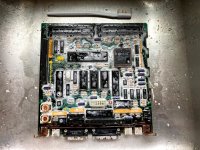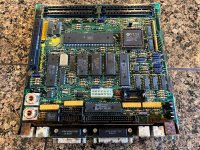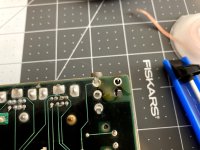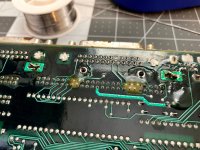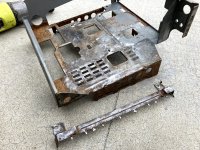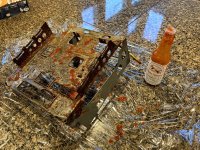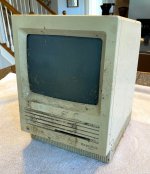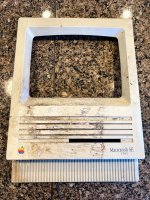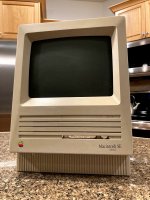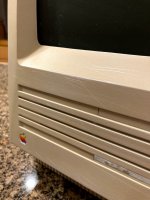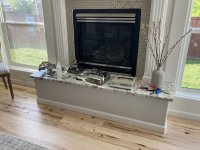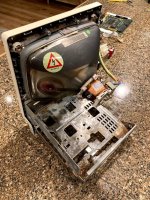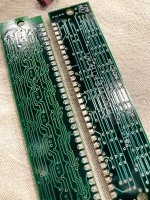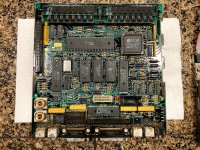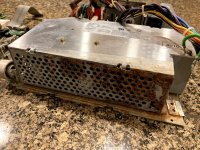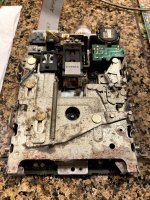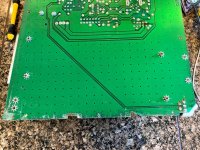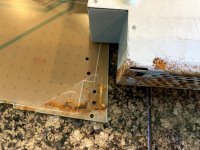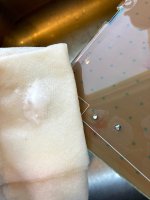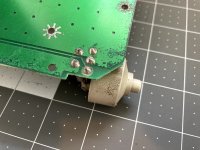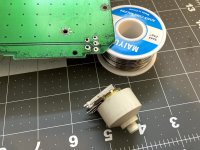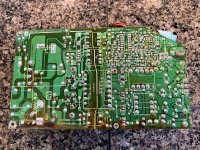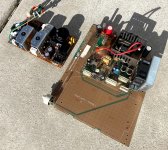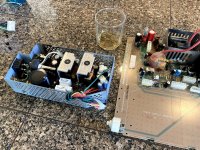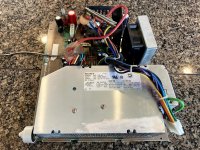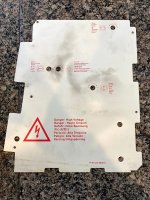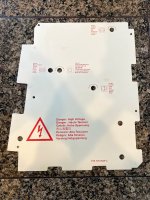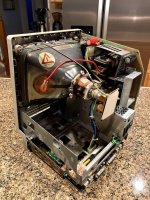PotatoFi
Well-known member
I received a Macintosh SE FDHD from a friend that is in very rough condition. In this thread, I'll attempt to [SIZE=1.4rem]revive it! Normally, I title these threads as "Restorations", but I don't think that's appropriate here due to the condition of the machine. I don't think it will ever look new again, but I want to see if I can get it working. And while I'm at it, I'll make it look as good as I can, because every Mac that we keep in circulation is another Mac in circulation![/SIZE]
Here's what we have to work with. It is extremely dirty, and the front is obviously very, very scratched. At this point, I couldn't tell the condition of the CRT because of all of the dirt.
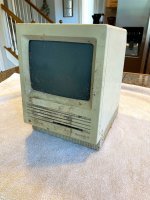
Yikes. Notice the rust stains around the bottom. That's not good.
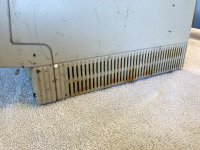
It gets worse. Check out the connectors on the back. At this point, it was becoming very clear to me that there was serious water damage.

Expecting the worst, I grabbed my impact driver and broke the screws loose. I was pretty anxious to get it apart.
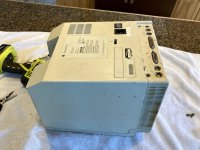
I wiggled the back bucket off, and this is what I was greeted with. Yikes. I seems that this machine sat in some water for awhile. I know it was in a 1940's basement for a couple of decades before coming to me.
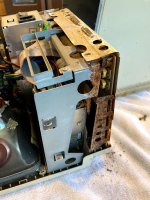
At this point, I was thinking, "Well... maybe the CRT could be useful in another machine." Or maybe, "I guess I can salvage the flyback."

I decided to keep going, and tear it completely down to see what I had to work with. Just to be safe, I followed the CRT discharge procedure of clipping a wire to the chassis and a screwdriver, and sliding the screwdriver under the anode cap. I'm sure this machine hasn't been powered on in ages, but better safe than sorry. I've done this on many compact black-and-white Macs, and I've never heard so much as a "click", but I always do it anyway.
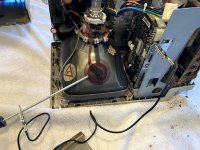
With the CRT discharge out of the way, I could starting tearing it down. But... where to start? The logic board was so rusted in that it wouldn't budge. I decided to unplug the floppy and hard drives first, but those were a struggle. Next, I removed the analog board. Check out the literal "water line". You can see exactly how far up the water came.
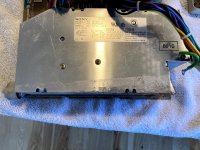
With the analog board removed, let's show another photo, just to drive home how totally trashed this machine is. My impact driver was key to getting a lot of the rusted screws loose.
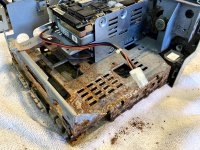
Next, I took the machine out to the garage to try to figure out how to get the logic board out. I don't have any photos of this, but I managed to get a screwdriver down to the battery and pop it out of the holder. Amazingly, it hadn't blown up.
I soaked the logic board rails in some WD-40 to try to loosen things up, and let it sit for a few hours.
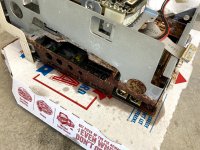
While that sat, my daughters helped me clean up the back bucket a bit. We used Dawn dish soap and toothbrushes, as usual. I think they're hoping for a dedicated Sim City machine for their playroom. We'll see.

With a bit of persuasion, I was able to get the logic board out. I ended up jamming a screwdriver in between the logic board and blending the rails out slightly to remove the board. They didn't permanently deform, but they did move just enough to sneak out the board. Sliding the board out was a complete impossibility.
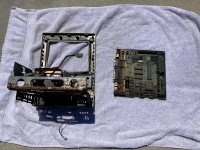
Here's the logic board up close. I think this is the point where any sane person would stop. But me? No. I decided to keep going.

I hit the logic board with a garden hose, and then stuck it into a tray of vinegar.
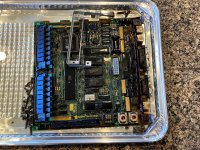
I stuck the screws in as well.
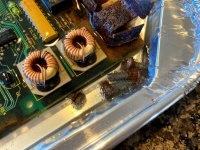
The amount of rust around the I/O ports caused me a great heck'n concern! But... let's let the vinegar do it's thing, and see what happens.
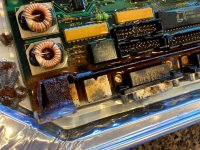
I scrubbed the board with a toothbrush after a couple of hours, and was surprised at how much it cleaned up. But there was still a ton of rust around the I/O ports, so my wife helped me find a creative solution to submerge the I/O ports with the limited amount of vinegar that we have on hand right now (shortage due to coronavirus).
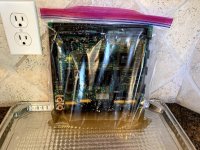
With that marinating, I removed the chassis from the front of the case. Wow, this thing looks horrible...
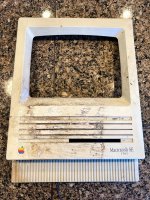
Hrm... I'll need to find a replacement Apple badge for it.
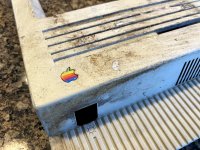
Using a pair of flush cutters, I removed the plastic parts that hold the speaker down.

And that's it for the night! Tomorrow, we'll take a look at the case and logic boards when they're all cleaned up.
Here's what we have to work with. It is extremely dirty, and the front is obviously very, very scratched. At this point, I couldn't tell the condition of the CRT because of all of the dirt.

Yikes. Notice the rust stains around the bottom. That's not good.

It gets worse. Check out the connectors on the back. At this point, it was becoming very clear to me that there was serious water damage.

Expecting the worst, I grabbed my impact driver and broke the screws loose. I was pretty anxious to get it apart.

I wiggled the back bucket off, and this is what I was greeted with. Yikes. I seems that this machine sat in some water for awhile. I know it was in a 1940's basement for a couple of decades before coming to me.

At this point, I was thinking, "Well... maybe the CRT could be useful in another machine." Or maybe, "I guess I can salvage the flyback."

I decided to keep going, and tear it completely down to see what I had to work with. Just to be safe, I followed the CRT discharge procedure of clipping a wire to the chassis and a screwdriver, and sliding the screwdriver under the anode cap. I'm sure this machine hasn't been powered on in ages, but better safe than sorry. I've done this on many compact black-and-white Macs, and I've never heard so much as a "click", but I always do it anyway.

With the CRT discharge out of the way, I could starting tearing it down. But... where to start? The logic board was so rusted in that it wouldn't budge. I decided to unplug the floppy and hard drives first, but those were a struggle. Next, I removed the analog board. Check out the literal "water line". You can see exactly how far up the water came.

With the analog board removed, let's show another photo, just to drive home how totally trashed this machine is. My impact driver was key to getting a lot of the rusted screws loose.

Next, I took the machine out to the garage to try to figure out how to get the logic board out. I don't have any photos of this, but I managed to get a screwdriver down to the battery and pop it out of the holder. Amazingly, it hadn't blown up.
I soaked the logic board rails in some WD-40 to try to loosen things up, and let it sit for a few hours.

While that sat, my daughters helped me clean up the back bucket a bit. We used Dawn dish soap and toothbrushes, as usual. I think they're hoping for a dedicated Sim City machine for their playroom. We'll see.

With a bit of persuasion, I was able to get the logic board out. I ended up jamming a screwdriver in between the logic board and blending the rails out slightly to remove the board. They didn't permanently deform, but they did move just enough to sneak out the board. Sliding the board out was a complete impossibility.

Here's the logic board up close. I think this is the point where any sane person would stop. But me? No. I decided to keep going.

I hit the logic board with a garden hose, and then stuck it into a tray of vinegar.

I stuck the screws in as well.

The amount of rust around the I/O ports caused me a great heck'n concern! But... let's let the vinegar do it's thing, and see what happens.

I scrubbed the board with a toothbrush after a couple of hours, and was surprised at how much it cleaned up. But there was still a ton of rust around the I/O ports, so my wife helped me find a creative solution to submerge the I/O ports with the limited amount of vinegar that we have on hand right now (shortage due to coronavirus).

With that marinating, I removed the chassis from the front of the case. Wow, this thing looks horrible...

Hrm... I'll need to find a replacement Apple badge for it.

Using a pair of flush cutters, I removed the plastic parts that hold the speaker down.

And that's it for the night! Tomorrow, we'll take a look at the case and logic boards when they're all cleaned up.

